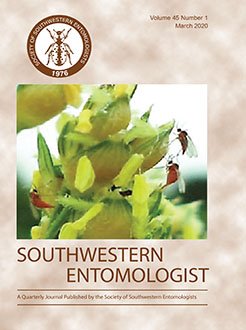The large grain borer, Prostephanus truncatus Horn, is a primary insect pest that reduces the quality and yield potential of stored cacahuacintle maize (Zea mays L.) in Mexico. Using external morphology to determine the sex of adults of the species is difficult. Digital images of 103 P. truncatus adults were processed, and the body length, abdomen length, abdomen width, and distance between clypeal tubercles were recorded from least to greatest according to the distance between clypeal tubercles. The sex of 10 insects of each of small (81.768-109.202 µm), medium (124.896-127.325 µm), and large sizes (143.668-186.901 µm) (16 males and 14 females) was corroborated by extraction of the genitalia. The dimensions were related to the sex of the insect. All small-sized insects were males, the medium-size category had 60% females and 40% males, and the large-size category was 100% female. Females had significantly greater body length (F1,30 = 8.67, P = 0.0062), abdomen length (F1,30 = 10.32, P = 0.0031), abdomen width (F1,28 = 2.02, P = 0.1659), and the distance between clypeal tubercles (F1,30 = 45.66, P < 0.0001) than did males. This complements the precision by other authors who determined the sex of adults of P. truncatus.
How to translate text using browser tools
31 March 2020
Sexual Differentiation of the Large Grain Borer, Prostephanus truncatus, by External Morphometry
Victor Manuel Gutierrez-Palomares,
Fabian Gutierrez-Chacon,
Jose Abel Lopez-Buenfil,
Claudio Chavarin-Palacio
ACCESS THE FULL ARTICLE

Southwestern Entomologist
Vol. 45 • No. 1
March 2020
Vol. 45 • No. 1
March 2020




